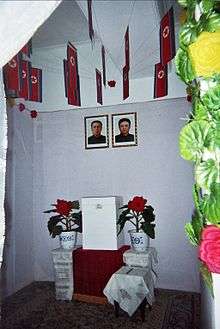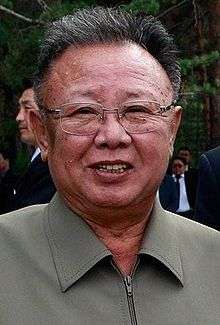North Korean parliamentary election, 2009
| | ||||||||||||||||||||||||||||||||
| ||||||||||||||||||||||||||||||||
| ||||||||||||||||||||||||||||||||
| ||||||||||||||||||||||||||||||||
 |
| This article is part of a series on the politics and government of North Korea |
|
|
| Foreign relations |
|
Politics portal |
Parliamentary elections in North Korea, creating the 12th Supreme People's Assembly, were held on 8 March 2009.[1] They were originally scheduled to be held in August 2008[2] but were postponed for unknown reasons. Observers of North Korea speculated that it was in relation to Kim Jong-il's ill health.[1]
All candidates standing in the elections in North Korea were members of one of the parties comprising the Democratic Front for the Reunification of the Fatherland. A single candidate, approved by the North-Korean leadership, ran in each of the 687 districts, thereby guaranteeing a full victory by the Democratic Front for the Reunification of the Fatherland, regardless of voter turnout.[3][4] Kim Jong-il, the de facto leader of North Korea and the Chairman of the National Defence Commission, ran for election in Constituency 333.[5]
Dissolution
The 11th Supreme People's Assembly was dissolved and elections were called for North Korea's 687 electoral districts on January 7, 2009.[1] The elections were to be originally held as per North Korea's constitution in August 2008.[2]
The delay was not officially explained, but was believed to be related to the health of Kim Jong-il. The elections also come after a significant cabinet shuffle in recent months that saw the replacement of at least five members of cabinet. The elections were called for March 8, 2009 allowing leave for a 60-day campaign period.[1]
After dissolution, nominating committees in all 687 districts nominated Kim Jong-il to stand for election. The 333rd district was the first to file their nomination, so he decided to run in that district. In the previous assembly, Kim Jong-il represented the 649th election district.[6]
Registration and voting method
Voter registration was conducted by the Resident Registration Bureaus of the National Security Agency. Completing the voters lists also had the side effect to discover missing residents who may have defected and left the country. Allegations have surfaced of bribes paid to officials conducting registration drives to declare family members who have defected as being deceased.[7] The voter registration deadline for the election took place on March 4, 2009.[8]
The bribes themselves have been overlooked by the National Security Agency as the North Korean government demands the lists be complete to ensure that there is 100% turnout in the vote. It is easier to explain missing persons as being dead than to have an incomplete voters list.[7]
The voting for deputies of the Supreme People's Assembly in 2009 consisted of using paper ballots containing the name of a single candidate nominated in each district. To indicate support for the candidate a ballot is dropped into the box unmarked. If the voter does not support a candidate, that voter must cross out the name of the candidate before dropping the ballot.[9]
The voting method is a departure from prior elections. In previous elections, the system consisted of two ballot boxes at each polling station. The boxes, one black and one white, were to indicate support for or against a candidate.[9] There is no system in place to handle absentee ballots for North Koreans living abroad and there does not appear to be a system of advanced voting in place.[10] Proxy votes were ordered cast by family members of North Korean defectors who were detained in prisons within China.[11] All voting and the validation of official returns is overseen by the Central Election Committee.[10]
Voting is supposed to be a secret process, but with the current method of casting ballots it becomes obvious who opposes candidates. The voter has the option of going to a booth to cross out the name or dropping the ballot directly in the box.[12] Penalties for voting against a candidate or not voting are severe. Electors who refused to vote were sent to Labor camps.[13] A member of the National Security Agency is stationed at every polling station to keep an eye out for people who use or look at the red pen.[14]
Disruption and vandalism
The election was a largely peaceful event, but some vandalism of candidate posters along with anti-election graffiti occurred in Mundeuk, South Pyongan Province.[15] Signage had also been changed on polling stations as official signage was replaced with new signs misspelling election booth.[13]
A tobacco factory being used as a polling station burst into flames in Sariwon. North Korean authorities claim the "arson" was masterminded by South Korean authorities who wanted to disrupt the election.[13]
World attention
The 2009 election in North Korea garnered significant attention from media agencies around the world. The attention was primarily to see if the potentially named successor to Kim Jong-il, Kim Jong-un was standing for a seat to the Supreme People's Assembly.
Rumors surfaced in the world media on 8 March 2009 that Kim Jong-un, the youngest son of Kim Jong-il, appeared on the ballot for the elections to the Supreme People's Assembly.[16] The rumors also stated that following the election the new parliament "may also replace members of [Kim's] cabinet and the National Defense Commission, the top ruling agency."[5]
The Central Election Commission via the Korean Central News Agency released the complete list of Deputies elected to the Supreme Peoples Assembly. The list showed that Kim Jong-un was not among those who were elected.[17] The results have left watchers of the regime in North Korea guessing as to the political future of the country.[18]
British Ambassador
The British Ambassador to North Korea Peter Hughes garnered significant outrage and controversy from around the world after he blogged about the election having a festive atmosphere.[19] The outrage was caused by claims that his blog read more like an official North Korean press release as he did not mention in his blog the negative aspects of the election such as citizens being forced to vote and that there is only a single candidate to vote for.[19]
Voting day and returns

Election day began with editorials being published in all state run media, encouraging voter participation.[20] Voting officially began at 9:00am local time.[21] Mobile polling stations were dispatched to infirm residents who could not travel to polling stations to cast ballots. Citizens of foreign nations resident in North Korea were also encouraged to come out and cast a ballot if they so wished.[22]
By noon on election day the Korean Central News agency had reported that 71% of registered North Korean voters had turned out to cast ballots.[23]
Voters in North Korea had dressed up for election day, wearing suits and chosŏn-ot traditional Korean dresses.[24]
| “ | I cast a ballot of patriotism, a ballot of approval with a mind to strengthen our socialist system—the best in the world, as firm as a rock. | ” | |
| — Kim Un Kyong, a North Korean factory worker | |||
The most watched race of the election was district 333 where leader Kim Jong-il was running. On March 9, 2009, North Korean media announced that Kim Jong-il was unanimously re-elected to parliament.[18] The election committee also stated that 99.98% of all registered voters took part in voting, with 100% voting for their candidate in each district.[25]
Official election results were announced by the Central Election Commission on March 2009.[3] The official results showed 324 of the 687 Deputies had been replaced and were new to power with the rest being re-elected. A large portion of the Deputies elected were to fill vacancies from those who died. No form of appointment or by-elections currently exists to put Deputies into the Supreme Peoples Assembly between elections.[26]
| Alliance | Party | Votes (%) | Seats |
|---|---|---|---|
| Democratic Front for the Reunification of the Fatherland | Workers' Party of Korea | 100.00% | 606 |
| Korean Social Democratic Party | 50 | ||
| Chondoist Chongu Party | 22 | ||
| General Association of Korean Residents in Japan | 6 | ||
| Independents | 3 | ||
| Total | 100.00% | 687 | |
| Turnout: 99.98% | |||
| Source:[27] | |||
References
- 1 2 3 4 "N Korea announces March election". BBC News. 2009-01-07.
- 1 2 "CIA World Factbook: North Korea". Central Intelligence Agency.
- 1 2 Moon, Angela; Sugita Katyal; Ralph Boulton (2009-03-08). "N.Korea vote may point to Kim successor". Reuters. Retrieved 2009-03-08.
- ↑ Sohn, Jie-Ae (2009-03-08). "N. Korea holds parliamentary elections". CNN. Retrieved 2009-03-08.
- 1 2 Choe, Sang-Hun (2009-03-08). "In North Korean Poll, Observers Look Down Ballot". New York Times. Retrieved 2009-03-08.
- ↑ "Kim Jong Il nominated as candidate for 11th SPA". Korean Central News Agency. July 1, 2003.
- 1 2 Lee Sung Jin (March 9, 2009). "Increasing "Deaths" ahead of SPA Election". Daily NK.
- ↑ "North Korea ends registration for upcoming election". Asiaone News. March 5, 2009.
- 1 2 "'Election' in North". The Korea Herald. March 10, 2009.
- 1 2 "Returns of SPA Election Announced". Korean Central News Agency.
- ↑ Lee Sung Jin (March 16, 2009). "Defectors Detained in Chinese Prison Cast Proxy Votes". Daily NK.
- ↑ "A look at North Korea's parliamentary election". Associated Press. March 6, 2009.
- 1 2 3 "Resistance against election sporadic but continued… spelling of ‘election’ sign changed". NKnetwork. March 25, 2009.
- ↑ James (March 27, 2009). "A guide to voting in North Korea". Japan Probe.
- ↑ "Anti-election Graffiti around Pyongang Province". Daily NK. April 14, 2009.
- ↑ "N Korea holds parliamentary poll". BBC News. March 8, 2009.
- ↑ "Kim Jong-il's son not among N Korea election winners". Australian Broadcasting Corporation. March 10, 2009.
- 1 2 "North Korea polls give no clue". Press Association. March 9, 2009.
- 1 2 Freeman, Colin (March 19, 2009). "Peter Hughes, Britain's ambassador to North Korea, in blogging row". The Daily Telegraph (London). Retrieved May 20, 2010.
- ↑ "All Citizens Called upon to Turn out in Election". Korean Central News Agency. March 8, 2009.
- ↑ "KPA Servicepersons Participate in Voting". Korean Central News Agency. March 8, 2009.
- ↑ "All Voters Participate in Voting". Korean Central News Agency. March 8, 2009.
- ↑ Cho, Kevin; Heejin Koo (2009-03-07). "North Korea Holds Parliamentary Elections Amid Rising Tensions". Bloomberg. Retrieved 2009-03-08.
- ↑ Choe Sang-Hun (March 8, 2009). "Amid a Vote, North Korea Awaits Clues to Its Future". New York Times.
- ↑ "N Korea's Kim wins parliamentary seat: official media". Agence France Press. March 9, 2009.
- ↑ Ser Myo-ja (March 11, 2009). "Kim Jong-il’s heir not seen on list of new lawmakers". JoongAng Daily.
- ↑ "IPU PARLINE Database: Democratic People's Republic of Korea, Parliamentary Chamber: Choe Go In Min Hoe Ui, Elections Held in 2009". Inter-Parliamentary Union.
External links
- Annotated full list of elected MP's (XLS) at North Korean Economy Watch
- Full list of candidates (English)
- Reported results of the election of deputies (Korean)
| ||||||||||
